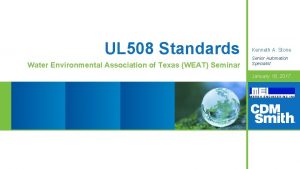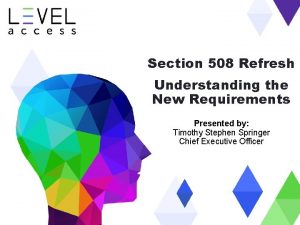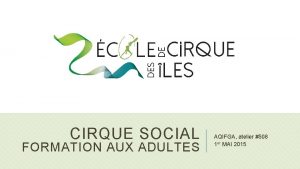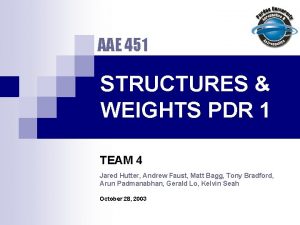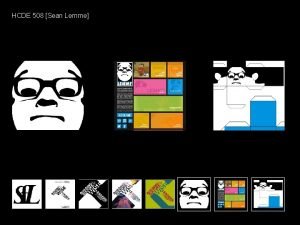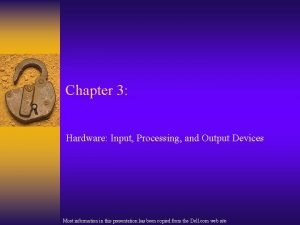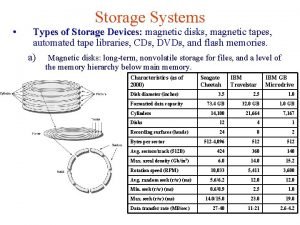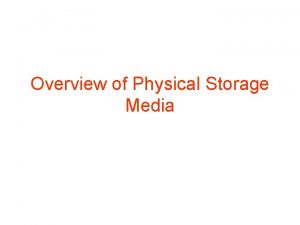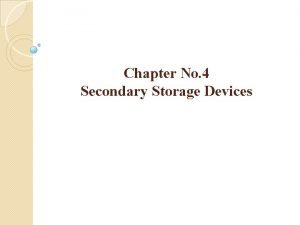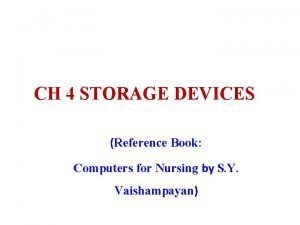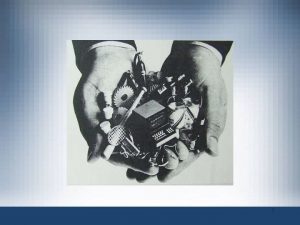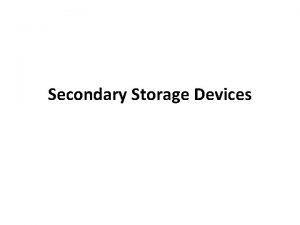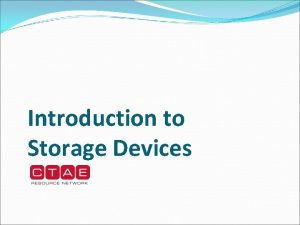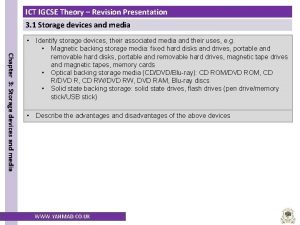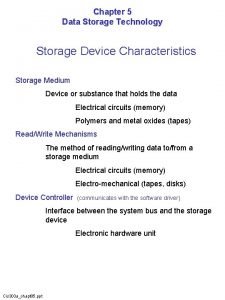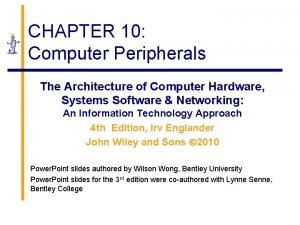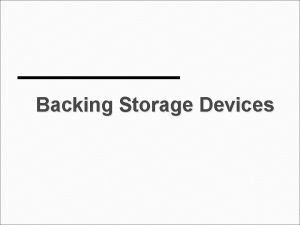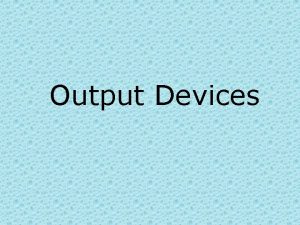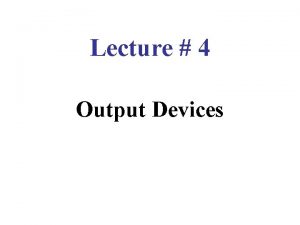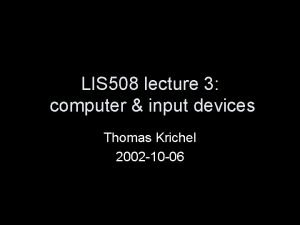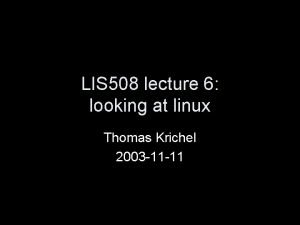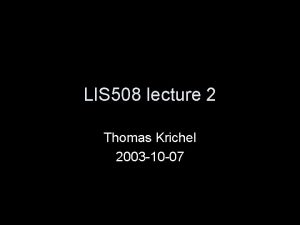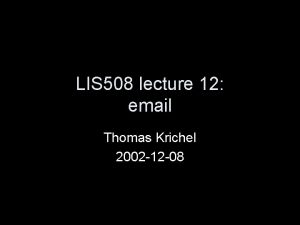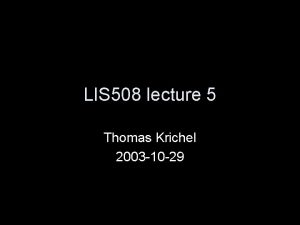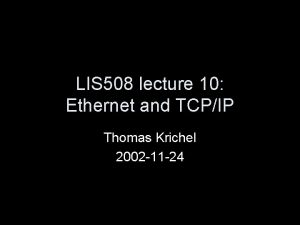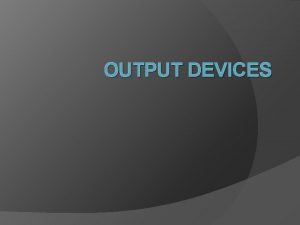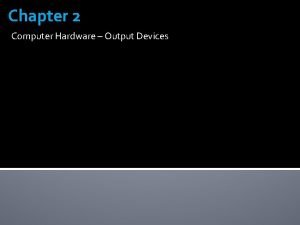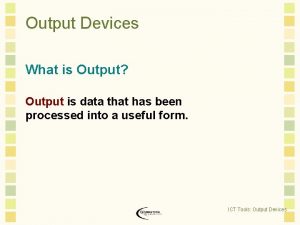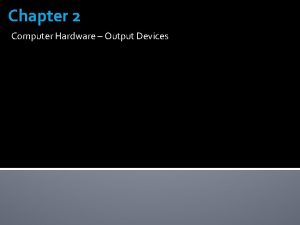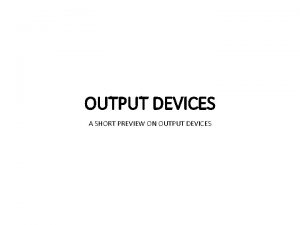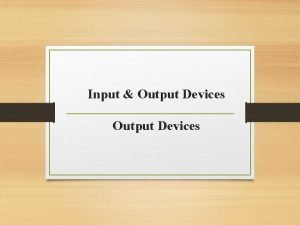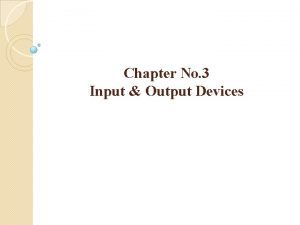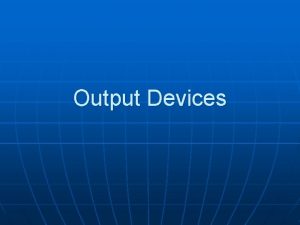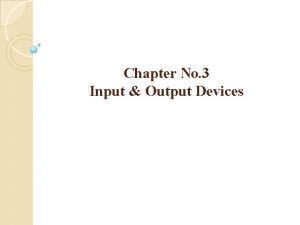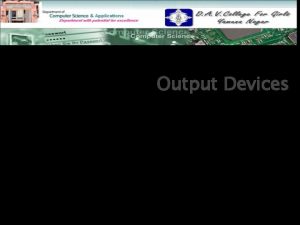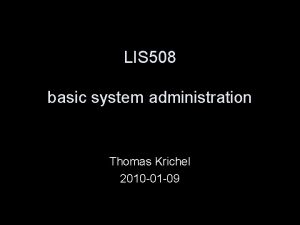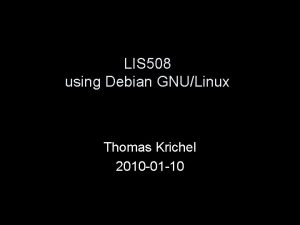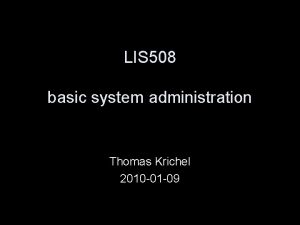LIS 508 lecture 4 storage output devices Thomas






























- Slides: 30

LIS 508 lecture 4: storage & output devices Thomas Krichel 2002 -10 -21

Today we have fun with • Output devices – Fundamental concepts – Hardcopies – Softcopies • Storage devices – disks • magnetic • optical

Literature • Output devices – Hutchinson and Sawyer chapter 3, part 2 • Storage devices – Hutchinson and Sawyer chapter 4

Fundamental concepts I • Pixel – A very small element of a picture – Inside the pixel color and brightness is fixed – All the pixels are created by the computer • Resolution – Number of pixels per inch – Or total number of pixels, confusion

Fundamental concepts II • Red-blue-green model. – Add colors red blue and green to various degrees to get pixels of any color – Additive model • Cyan-Magenta-Yellow – Uses basic color cyan, magenta, yellow, to absorb light on the surface – Subtractive color model

Output comes in two forms • Tangible or hardcopy output – Card puncher – Printer • Intangible or softcopy output – Monitor display screens – Loudspeaker output

Hardcopy to printers • Printer prints – character symbols – Graphics • Output quality is measured in dpi dots per inch • Printers vary from 60 to 1500 dpi • 600 dpi seems common

Types of printers: impact • Forms characters or images by mechanic strikes of a print hammer or wheel. • One example is a typewriter. • Most common form is the dot matrix printer – – – Head with small pins (9, 18, 24) Strike ribbon against paper Do 72 to 144 dpi, 30 to 400 chars Noisy Image may smear

Types of printers: non-impact • Form characters and images without physical contact • Less moving parts, less noise • Two forms – Laser printer – Inkjet printer

Laser printer • Images are produced on a drum • A laser beam sets electrical charge on dots on the drum • Magnetically charged powder called toner flies to the electrified dots on the drum • The drum rolls the toner on the paper • A second drum burns the toner on the paper

Laser printer performance • Can print 200 pages per minute provided that the computer can chunk out the data that fast • Can print a lot of different fonts • More fancy models can even do color • Use a page description language to generate the images

Inkjet printer • Spray tiny, electrically charged drops of ink from 64 nozzles through holes in a matrix onto paper • There are usually four cartages of colored ink (cyan, magenta, yellow, black) • Head moves around and software says where to spray

Inkjet printer performance • Can print color at much less cost than laser printer • Lower resolution than a color laser printer • Slow, one page may take up to 10 minutes • More expensive to operate than a color laser printer when you have to print a lot of color.

multifunction printers • Device that can print, scan, copy and fax • When one component is kaputt, you can not indulge in any of the activities

Softcopy output: monitor • Size is measured diagonally from corner to corner in inches, not the size of the viewing area • Common sizes are 13, 15, 17, 19, 21 • There are two types – Cathode-ray tube CRT – Flat panel displays • All display an image through a number of pixels, individual dots that make it up

Display quality • Dot pitch is the amount of space between adjacent pixels, usually measure in millimeters • Resolution is the number of pixels measured as horizontal pixel number × vertical pixel number. • Refresh rate is the number of times per second the pixels are recharged. > 75 is ok • Color dept, 8 bit, 16 bit and 32 bit, true color. It is often not necessary to have true color. It is better to have higher resolution and less colors.

Types of flat panel monitors • Passive matrix display: one transistor controls a whole row or column of pixels. – good for monochrome – but not for color. – less expensive – Lower energy consumption • Active matrix display, aka thin film transmission TFT: each pixel has its own transistor

CRT monitors • Have a three rays that paint red blue and green • They emit beams that hit phosphate in the screen surface • Light is emitted • Analogue technology

Moving from CRT to TFT • Video card still emit analog beam signals to the monitor. • They have to be converted to the flat panel signal that is digital • Causes some performance losses. • Slow conversion to flat panel technology • Likely to be taken up outside IT, like in art for example

RAM and disks • RAM is random access memory. • It is the operational main storage on a computer. • It is live memory. When the computer is switched of it dies. • Therefore we need to store on other devices, that store when switched off. • The most important are disks.

Structure of a disk • Disks are round devices divided into tracks and sectors. • A hard disk may have several physical disks. All tracks on the same location in different disks from a cylinder. • Disks are divided into sectors. – A sector is usually 571 bytes long – 512 bytes are used by the user – The rest is reserved for disk operation • The disk spins, a head reads and writes data.

Data integrity • The special data in each sector is kept there to try ensure that the user data is safe. • It contains a summary of the user data. • When the summary and the user data no longer match, the summary can be used to correct the user data. • Modern disks can monitor if they are a in good shape, and move data from good to bad sectors.

Formatting a floppy • Physical formatting: – writing tracks – writing sectors • Logical formatting: – labeling each sector – create boot record – windows: create file allocation table (FAT)

Formatting a hard disk • That is the same as formatting a floppy but • Between physical and logical formatting, the hard disk may be partitioned. • This allows for several logical disks on the same physical disk • Therefore the boot record is more complicated than on the floppy and called a master boot record MBR. • Example: dual boot Linux/Windows machine

Windows logical disks • Floppies use FAT 12 format – The boot records is exactly one sector long – therefore called the boot sector – Does not allow for long file names • The logical disks on a hard disks may use FAT 32 format if larger than 512 Mb – System area • Boot record • FAT – User area – Can handle disks of the size of 2 tera bytes

disk architecture on a PC: IDE • IDE integrated device electronics is the classic architecture. An IDE controller chip allows for 2 times 2 disks – primary / secondary – master / slave • The master/slave setup is controlled by jumper settings. Consult manufacturer's web site.

disk architecture on a PC: SCSI • SCSI small computer systems interface allows to daisy chain many devices and gives control of the hard disk to the computer, resulting in – faster operation – more expensive – less standardized • not as popular as predicted.

optical disks • CD-ROMs can store up to 6 Mega Bytes • CD-R holds the same storage, it is recordable once. • CD-RW are read and writable, but does not have the same capacity, because it uses some magnetic technology. • DVDs can hold up to 17 Giga Bytes. Used by the contents industries.

backups • There is a song of the Beatles… • The backup utility is based in the “system tools” section of programs/accessories. • It also has an emergency repair tool, that lets you fix things. • It is best to define a backup job, and then run it at scheduled times. • Time between jobs needs to be chosen with care.

http: //openlib. org/home/krichel Thank you for your attention!
 Input output storage devices
Input output storage devices Input and output devices of computer
Input and output devices of computer 01:640:244 lecture notes - lecture 15: plat, idah, farad
01:640:244 lecture notes - lecture 15: plat, idah, farad Ul508 vs ul508a
Ul508 vs ul508a Section 508 update
Section 508 update Revised 508 standards
Revised 508 standards Atelier 508
Atelier 508 Aae 508 purdue
Aae 508 purdue Micro-purchases and section 508 requirements
Micro-purchases and section 508 requirements Drupal 508 compliance
Drupal 508 compliance Dhs section 508
Dhs section 508 Hcde 508
Hcde 508 Secondary storage vs primary storage
Secondary storage vs primary storage Storage devices of computer
Storage devices of computer Uses rigid metallic platters
Uses rigid metallic platters Unified storage vs traditional storage
Unified storage vs traditional storage Pathologist and anthropologist
Pathologist and anthropologist Input process output storage
Input process output storage Power semiconductor devices lecture notes
Power semiconductor devices lecture notes Memoryqq
Memoryqq Secondary storage device
Secondary storage device What is physical storage media
What is physical storage media Output device
Output device Optical disc
Optical disc Types of storage devices
Types of storage devices Magnetic tape secondary storage
Magnetic tape secondary storage Secondary storage devices that use laser technology
Secondary storage devices that use laser technology Igcse ict chapter 3
Igcse ict chapter 3 Storage devices characteristics
Storage devices characteristics Computer peripherals storage devices
Computer peripherals storage devices Backing storage
Backing storage



